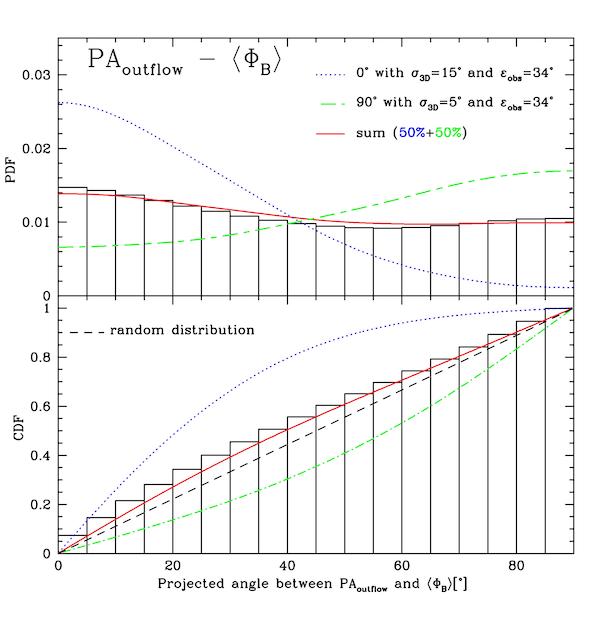
6.7 GHz CH3OH masers polarisation in massive star-forming regions: the Flux-Limited Sample
by Gabriele Surcis (INAF - Osservatorio Astronomico di Cagliari, Italy)

distribution function (CDF, bottom panel) of the projected angle between the magnetic
field and the outflow axis (|PAoutflow-<ΦB>|). The dashed black line is the CDF
for a completely random orientation of outflows and magnetic fields. More details
in Surcis et al. (2022, A&A, 658, A78).
One of the still open questions of modern astrophysics is the formation process of high-mass stars, which have masses greater than 10 solar masses. The observational and theoretical efforts made in the last decades have shown that a common and essential component in the formation of high-mass stars is the presence of molecular outflows during the protostellar phase, similarly to what is observed during the formation of low-mass stars. Theoretically, it has been convincingly demonstrated that the magnetic field plays an important role in launching molecular outflows in massive young stellar objects. Here, for instance, the presence of a magnetic field helps the formation of early outflows that can reduce the radiation pressure through cavities; this partially solves the well-known radiation problem of high-mass star formation allowing the protostar mass to grow further. In addition, the intensity of the magnetic field may influence the collimation of the outflows. Although there is a large consensus on the theoretical importance of magnetic fields in launching the outflows, there are still some open issues from an observational point of view. For instance, the alignment of the magnetic field lines with the outflows. Therefore, providing new measurements of magnetic fields close (10s-100s astronomical units) to massive young stellar objects is of great importance. This can be achieved only by observing the polarised emission of molecular masers by using the very long baseline interferometry (VLBI) technique. Indeed, dust polarimetric observations towards massive star-forming regions are often limited to low density regions and/or envelopes at scales of several thousands astronomical units making them not suitable for probing the full structure of the magnetic field close to the protostars where the outflows are launched. Among the different maser species, the best probes for this purpose are the methanol masers, and in particular the 6.7 GHz transition.
After the successful pilot observations of the polarised emission of 6.7 GHz methanol maser made with the European VLBI Network (EVN) in 2009 (Surcis et al. 2009), we started a large EVN campaign to measure the magnetic field orientation and strength towards a sample of 30 massive star-forming regions. This is called the “flux-limited sample”. The flux-limited sample is composed of massive star-forming regions with declination greater than -9° and with a total methanol single-dish flux density >50 Jy, as reported in the catalogue of 6.7 GHz methanol masers compiled by Pestalozzi et al. (2005, A&A, 432,737). The EVN campaign lasted more than ten years and the results have been published in a series of papers (Surcis et al., 2011, 2012, 2013, 2015, 2019, 2022). In the last one, Surcis et al. (2022, A&A, 658, A78), besides reporting the results of the last five sources, we have presented the statistical analysis of the entire sample.
We were able to measure the magnetic field orientation in all sources but one. This allowed us to compare the orientation of the magnetic field (<ΦB>) with the orientation of the outflows (PAoutflow) on the plane of the sky. The probability distribution of the angles |PAoutflow-<ΦB>| is shown in Figure 1. To investigate the distribution of these angles in the 3D space we have performed two Monte Carlo simulation runs, one considering the outflow and the magnetic field parallel in the 3D space and then projected on the plane of the sky (dot-dashed green line in Figure1) and the other when they are perpendicular in the 3D space and then projected on the plane of the sky (dotted blue line in Figure 1). We found that only a combination of the two distributions (50%-50%, red line in Figure 1) represents what we observe. Therefore, we see a perfect bimodal distribution in the difference between the 3D magnetic field direction and the outflow axis. A slightly similar distribution was observed by Zhang et al. (2014, ApJ, 781, 89) on scales greater than 1000 au obtained by observing dust polarised emissions, although due to their small sample size they concluded that the data were consistent more with a random distribution.
Furthermore, because we measured in total linear polarisation fraction (Pl) and circular polarisation fraction (PV) for 233 and 33 6.7 GHz methanol maser features towards the sources of the flux-limited sample, we were also able to determine for this maser transition the typical values of Pl , PV, and of the Zeeman-splitting (ΔVz). These are Pl = 1.0-2.5%, PV = 0.5-0.75%, and ΔVz = 0.5-2.0 ms-1 (see Figure 2) that would correspond to 9 mG <|B|||< 40 mG if F = 3 → 4 is the hyperfine transition that contributes most to the 6.7 GHz methanol maser emission.
Published in Surcis et al. 2022, A&A, 658, A78